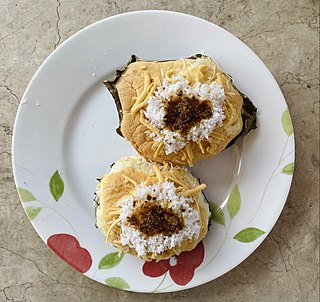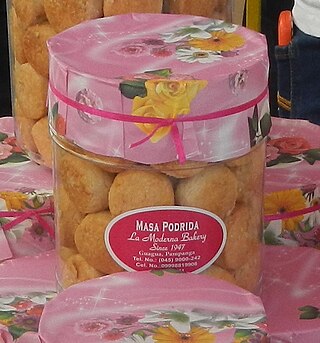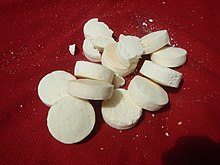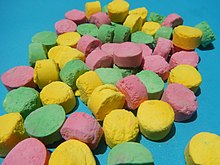
Mochi is a Japanese rice cake made of mochigome (もち米), a short-grain japonica glutinous rice, and sometimes other ingredients such as water, sugar, and cornstarch. The steamed rice is pounded into paste and molded into the desired shape. In Japan, it is traditionally made in a ceremony called mochitsuki. While eaten year-round, mochi is a traditional food for the Japanese New Year, and is commonly sold and eaten during that time.

Glutinous rice is a type of rice grown mainly in Southeast and East Asia, and the northeastern regions of South Asia, which has opaque grains, very low amylose content, and is especially sticky when cooked. It is widely consumed across Asia.

Rice pudding is a dish made from rice mixed with water or milk and other ingredients such as cinnamon, vanilla, and raisins.

Kuih are bite-sized snack or dessert foods commonly found in Southeast Asia and China. It is a fairly broad term which may include items that would be called cakes, cookies, dumplings, pudding, biscuits, or pastries in English and are usually made from rice or glutinous rice. In China, where the term originates from, kueh or koé (粿) in the Min Nan languages refers to snacks which are typically made from rice but can occasionally be made from other grains such as wheat. The term kuih is widely used in Malaysia, Brunei, and Singapore, kueh is used in Singapore and Indonesia, kue is used in Indonesia only, all three refer to sweet or savoury desserts.

Filipino cuisine is composed of the cuisines of more than a hundred distinct ethnolinguistic groups found throughout the Philippine archipelago. A majority of mainstream Filipino dishes that compose Filipino cuisine are from the food traditions of various ethnolinguistic groups and tribes of the archipelago, including the Ilocano, Pangasinan, Kapampangan, Tagalog, Bicolano, Visayan, Chavacano, and Maranao ethnolinguistic groups. The dishes associated with these groups evolved over the centuries from a largely indigenous base shared with maritime Southeast Asia with varied influences from Chinese, Spanish, and American cuisines, in line with the major waves of influence that had enriched the cultures of the archipelago, and adapted using indigenous ingredients to meet local preferences.

A buñuelo (Spanish:[buˈɲwelo], alternatively called boñuelo, bimuelo, birmuelo, bermuelo, bumuelo, burmuelo, or bonuelo, is a fried dough fritter found in Spain, Latin America, and other regions with a historical connection to Spaniards, including Southwest Europe, the Balkans, Anatolia, and other parts of Asia and North Africa. Buñuelos are traditionally prepared at Christmas. It will usually have a filling or a topping. In Mexican cuisine, it is often served with a syrup made with piloncillo.

Bibingka commonly refers to a type of baked rice cake from the Philippines that is traditionally cooked in a terracotta oven lined with banana leaves and is usually eaten for breakfast or as merienda especially during the Christmas season. It is also known as bingka in the Visayas and Mindanao islands.

A rice cake may be any kind of food item made from rice that has been shaped, condensed, or otherwise combined into a single object. A wide variety of rice cakes exist in many different cultures in which rice is eaten. Common variations include cakes made with rice flour, those made from ground rice, and those made from whole grains of rice compressed together or combined with some other binding substance.

Kue is a Southeast Asian bite-sized snack or dessert, especially in Brunei, Indonesia, Malaysia and Singapore. Kue or kuih are fairly broad terms in the Malay archipelago to describe a wide variety of snacks including cakes, cookies, fritters, pies, scones, and patisserie. Kue are made from a variety of ingredients in various forms; some are steamed, fried or baked. They are popular snacks in the Malay archipelago, which has the largest variety of kue. Because of the archipelago's historical colonial ties, Koeé (kue) is also popular in the Netherlands.

Puto is a Filipino steamed rice cake, traditionally made from slightly fermented rice dough (galapong). It is eaten as is or as an accompaniment to a number of savoury dishes. Puto is also an umbrella term for various kinds of indigenous steamed cakes, including those made without rice. It is a sub-type of kakanin.

Mamón are traditional Filipino chiffon or sponge cakes, typically baked in distinctive cupcake-like molds. In the Visayas regions, mamón are also known as torta mamón or torta. Variants of mamón include the larger loaf-like version called taisan, the rolled version called pianono, and ladyfingers known as broas. Mamón also has two very different variants that use mostly the same ingredients, the cookie-like mamón tostado and the steamed puto mamón.

A polvorón is a type of heavy, soft, and very crumbly Spanish shortbread made of flour, sugar, milk, and nuts. They are mostly produced in Andalusia, where there are about 70 factories that are part of a syndicate that produces polvorones and mantecados. Under the name mantecados, these sweets are a traditional preparation of other areas of the Iberian Peninsula and other Spanish-speaking countries as well.

Kalamai is a traditional Chamorro corn / coconut pudding, sometimes referred to as coconut gelatin. Original versions of kalamai called for masa harina, coconut milk, sugar, and water. Subsequently, cornstarch has been used to thicken the dessert. Red or green food coloring may be used to color the kalamai, followed by a sprinkling of cinnamon on the surface. A few recipes add vanilla for additional flavoring.

Puto bumbong is a Filipino purple rice cake steamed in bamboo tubes. It is traditionally sold during the Christmas season. It is a type of puto.

Okoy or ukoy, are Filipino crispy deep-fried fritters made with glutinous rice batter, unshelled small shrimp, and various vegetables, including calabaza, sweet potato, cassava, mung bean sprouts, scallions and julienned carrots, onions, and green papaya. They are traditionally served with vinegar-based dipping sauces. They are eaten on their own or with white rice. They are popular for breakfast, snacks, or appetizers. Okoy are sometimes dyed bright orange with achuete seeds.
Sayongsong is a traditional Filipino steamed rice cake from Surigao del Norte and other areas of the Caraga Region of northeastern Mindanao, as well as the southeastern Visayas where it is known as sarungsong or alisuso. It is distinctively served in cone-shaped banana leaves. Sayongsong is a type of puto.

Uraró, also known as araró or arrowroot cookies, are Filipino cookies made from arrowroot flour. They have a dry and powdery texture and are usually flower-shaped. They originate from the Tagalog people of southern Luzon, particularly in the provinces of Laguna, Quezon, and Marinduque.

Masa podrida are traditional Filipino shortbread cookies made from flour, salt, baking powder, brown sugar, shortening, and eggs. It has a dry crumbly texture similar to half-moon cookies. The name comes from Spanish for "rotten dough". Masa podrida are typically eaten with coffee and other hot drinks.



















